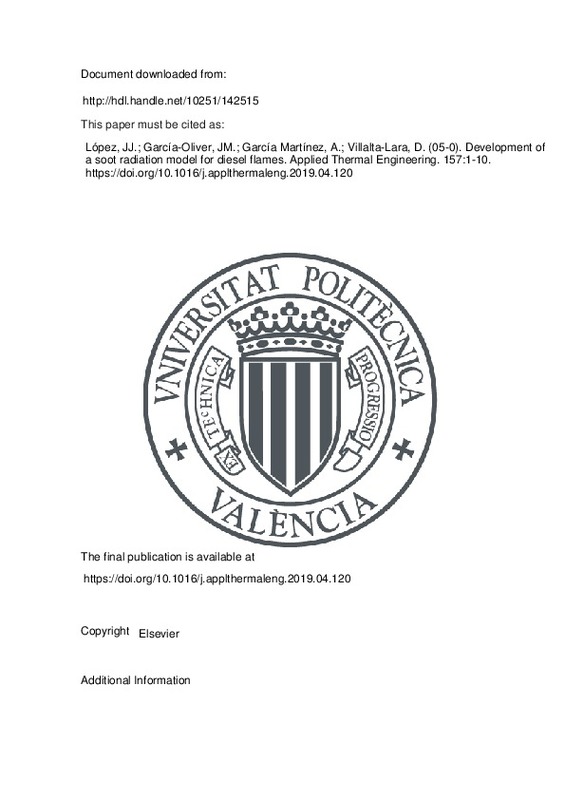JavaScript is disabled for your browser. Some features of this site may not work without it.
Buscar en RiuNet
Listar
Mi cuenta
Estadísticas
Ayuda RiuNet
Admin. UPV
Development of a soot radiation model for diesel flames
Mostrar el registro sencillo del ítem
Ficheros en el ítem
| dc.contributor.author | López, J. Javier
|
es_ES |
| dc.contributor.author | García-Oliver, José M
|
es_ES |
| dc.contributor.author | García Martínez, Antonio
|
es_ES |
| dc.contributor.author | Villalta-Lara, David
|
es_ES |
| dc.date.accessioned | 2020-05-06T07:17:55Z | |
| dc.date.available | 2020-05-06T07:17:55Z | |
| dc.date.issued | 2019-07-05 | es_ES |
| dc.identifier.issn | 1359-4311 | es_ES |
| dc.identifier.uri | http://hdl.handle.net/10251/142515 | |
| dc.description.abstract | [EN] This paper describes a radiation model for diesel sprays that can predict the heat losses based on spray characteristics to the spray plume due to radiation. The model is based on three sub-models: spray model, soot model and radiation model. The spray model is a one-dimensional model that simulates the axial and radial distribution of a fuel spray for each instant. The soot model is a one-dimensional tool, which is based on formation and oxidation processes calculating the axial and radial soot concentration profile for each instant. The output results of the two sub-models are used as input information for the radiation model, which obtains the radiation heat transfer values for a diesel flame. The experimental measurements used to adjust the different constants and to validate the sub-models were performed in a high-pressure high-temperature vessel using three different optical techniques: Schlieren, to obtain spray penetration, Diffused Back-Illumination technique (DBI) for the soot concentration and the 2-color method for calculating the soot temperature and concentration. The radiant fraction shows values from 0.11% to 0.43% with respect to the total energy of the fuel depending on the operating condition. Taking into account the different assumptions taken for modeling the spray radiation, these results are consistent with those obtained in the literature, in which the radiation was characterized under similar conditions. | es_ES |
| dc.description.sponsorship | The authors acknowledge FEDER and Spanish Ministerio de Economía y Competitividad for partially supporting this research through TRANCO project (TRA2017-87694-R). | es_ES |
| dc.language | Inglés | es_ES |
| dc.publisher | Elsevier | es_ES |
| dc.relation.ispartof | Applied Thermal Engineering | es_ES |
| dc.rights | Reserva de todos los derechos | es_ES |
| dc.subject | Radiation | es_ES |
| dc.subject | Soot | es_ES |
| dc.subject | Heat transfer | es_ES |
| dc.subject | Spectral intensity | es_ES |
| dc.subject | Soot radiation model | es_ES |
| dc.subject.classification | MAQUINAS Y MOTORES TERMICOS | es_ES |
| dc.title | Development of a soot radiation model for diesel flames | es_ES |
| dc.type | Artículo | es_ES |
| dc.identifier.doi | 10.1016/j.applthermaleng.2019.04.120 | es_ES |
| dc.relation.projectID | info:eu-repo/grantAgreement/AEI/Plan Estatal de Investigación Científica y Técnica y de Innovación 2013-2016/TRA2017-87694-R/ES/REDUCCION DE CO2 EN EL TRANSPORTE MEDIANTE LA INYECCION DIRECTA DUAL-FUEL DE BIOCOMBUSTIBLES DE SEGUNDA GENERACION/ | es_ES |
| dc.rights.accessRights | Abierto | es_ES |
| dc.contributor.affiliation | Universitat Politècnica de València. Departamento de Máquinas y Motores Térmicos - Departament de Màquines i Motors Tèrmics | es_ES |
| dc.description.bibliographicCitation | López, JJ.; García-Oliver, JM.; García Martínez, A.; Villalta-Lara, D. (2019). Development of a soot radiation model for diesel flames. Applied Thermal Engineering. 157:1-10. https://doi.org/10.1016/j.applthermaleng.2019.04.120 | es_ES |
| dc.description.accrualMethod | S | es_ES |
| dc.relation.publisherversion | https://doi.org/10.1016/j.applthermaleng.2019.04.120 | es_ES |
| dc.description.upvformatpinicio | 1 | es_ES |
| dc.description.upvformatpfin | 10 | es_ES |
| dc.type.version | info:eu-repo/semantics/publishedVersion | es_ES |
| dc.description.volume | 157 | es_ES |
| dc.relation.pasarela | S\387950 | es_ES |
| dc.contributor.funder | Agencia Estatal de Investigación | es_ES |







![[Cerrado]](/themes/UPV/images/candado.png)

